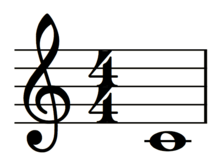MusicXML
| Filename extension |
.xml, .mxl |
|---|---|
| Internet media type |
application/vnd.recordare.musicxml+xml,[1] application/vnd.recordare.musicxml[2] |
| Developed by | Recordare, MakeMusic |
| Latest release |
3.0 (August 2011[3]) |
| Type of format | Musical notation |
| Extended from | XML |
| Open format? | Yes |
MusicXML is an XML-based file format for representing Western musical notation. The format is proprietary, but fully and openly documented, and can be freely used under a Public License.[4]
History
MusicXML was developed by Recordare LLC, deriving several key concepts from existing academic formats (such as Walter Hewlett's MuseData and David Huron's Humdrum). It is designed for the interchange of scores, particularly between different scorewriters. MusicXML development is currently managed by MakeMusic following the company's acquisition of Recordare in 2011.[5][6]
Version 1.0 was released in January 2004. Version 1.1 was released in May 2005 with improved formatting support. Version 2.0 was released in June 2007 and included a standard compressed format.[7] All of these versions were defined by a series of document type definitions (DTDs). An XML Schema Definition (XSD) implementation of Version 2.0 was released in September 2008. Version 3.0 was released in August 2011 with improved virtual instrument support, in both DTD and XSD versions.[8][9] The MusicXML DTDs and XSDs are each freely redistributable under the MusicXML Public License.[10]
Support
As of December 2015, MusicXML is supported to varying degrees by over 210 notation programs.[11][12] These programs include:
- Most scorewriting programs, including Finale, Sibelius, and MuseScore.
- Most Music OCR programs, including SmartScore and PhotoScore.
- Most music sequencer programs, including Cubase, Logic Pro, Digital Performer, and SONAR.
Additionally, web support is possible through the use of the HTML5 canvas element and JavaScript resulting in the rendering of legible music within a web browser.[13]
Features include key and time signatures, clefs, beaming information, stem directions, slurs, ornaments, barlines, and written repeats.[14]
Example
Like all XML-based formats, MusicXML is intended to be easy for automated tools to parse and manipulate. Though it is possible to create MusicXML by hand, interactive score writing programs like Finale and MuseScore greatly simplify the reading, writing, and modifying of MusicXML files.
The following example is a score consisting of a single whole note middle C in the key of C major on the Treble Clef.[15]

<?xml version="1.0" encoding="UTF-8" standalone="no"?>
<!DOCTYPE score-partwise PUBLIC
"-//Recordare//DTD MusicXML 3.0 Partwise//EN"
"http://www.musicxml.org/dtds/partwise.dtd">
<score-partwise version="3.0">
<part-list>
<score-part id="P1">
<part-name>Music</part-name>
</score-part>
</part-list>
<part id="P1">
<measure number="1">
<attributes>
<divisions>1</divisions>
<key>
<fifths>0</fifths>
</key>
<time>
<beats>4</beats>
<beat-type>4</beat-type>
</time>
<clef>
<sign>G</sign>
<line>2</line>
</clef>
</attributes>
<note>
<pitch>
<step>C</step>
<octave>4</octave>
</pitch>
<duration>4</duration>
<type>whole</type>
</note>
</measure>
</part>
</score-partwise>
The textual representation listed above is verbose; MusicXML v2.0 addresses this by adding a compressed zip format with a .mxl suffix that can make files roughly one-twentieth the size of the uncompressed version.[16]
See also
- List of document markup languages
- Comparison of document markup languages
- MIDI
- Music Encoding Initiative (MEI)
- Music Markup Language
- Notation Interchange File Format (NIFF)
- Scorewriter
References
- ↑ "Type name: application : Subtype name: vnd.recordare.musicxml+xml". Iana.org. Retrieved 24 November 2014.
- ↑ "Type name: application : Subtype name: vnd.recordare.musicxml". Iana.org. Retrieved 24 November 2014.
- ↑ "MusicXML 3.0 Specification". MusicXML.com. MakeMusic, Inc. Retrieved 26 February 2013.
- ↑ "Sustainability of Digital Formats Planning for Library of Congress Collections — MusicXML, Version 3". Library of Congress. 9 October 2012. Retrieved 14 November 2012.
- ↑ "Recordare Closing Release" (PDF). Makemusic.com. Retrieved 13 December 2014.
- ↑ "MAKEMUSIC, INC. ENHANCES TECHNOLOGY LEADERSHIP BY PURCHASING RECORDARE ASSETS" (PDF). Tech.mn. Retrieved 13 December 2014.
- ↑ "Compressed MXL Files". MusicXML. Retrieved 2014-06-27.
- ↑ "Version History of MusicXML". Musicxml.com. Retrieved 2014-06-27.
- ↑
- ↑ "MusicXML, Version 3". Digitalpreservation.gov:8081. 2012-10-09. Retrieved 2014-06-27.
- ↑ "Software". MusicXML. 2010-03-19. Retrieved 2015-12-08.
- ↑ "File format". MuseScore. Retrieved 2014-06-27.
- ↑ "HTML5 MusicXML Viewer". Musicxml-viewer.com. 2012-05-15. Archived from the original on 2016-04-03. Retrieved 2014-06-27. Source code available in Google Code, Github and Bitbucket.
- ↑ Juan Pablo Bello, Elaine Chew, Douglas Turnbull (2008) ISMIR 2008: Proceedings of the 9th International Conference p.365
- ↑ "Hello World: A One-Bar Song with a Whole Note on Middle C in 4/4 time". Musicxml.com. Retrieved 2014-06-27.
- ↑ "MusicXML FAQ". MusicXML. Retrieved 13 December 2014.